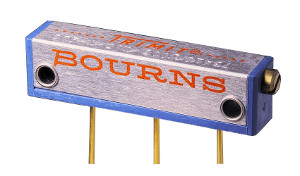Home > Textbooks > Basic Electronics > Resistors > Variable Resistors >
Resistors
Variable Resistors
Variable resistors are intended for use in applications where the equipment user has frequent requirement for adjusting the resistance, as in tone, volume, focus, and brightness controls. There are two basic types of variable resistors, one called a potentiometer and the other a rheostat. An example of the potentiometer is the volume control on your radio, and an example of the rheostat is the dimmer control for the dash lights in an automobile. There is a slight difference between them. Rheostats usually have two connections, one fixed and the other moveable. Any variable resistor can properly be called a rheostat. The potentiometer always has three connections, two fixed and one moveable. Generally, the rheostat has a limited range of values and a high current-handling capability. The potentiometer has a wide range of values, but it usually has a limited current-handling capability. Potentiometers are usually connected as voltage dividers.
Potentiometer
An example of a potentiometer is shown in the figure below, view A. Potentiometers are made with either composition or wirewound resistance elements, and all considerations to be mentioned in connection with fixed resistors having those types of elements also apply to potentiometers.

The basic components of the most widely used types of potentiometers are shown in the figure above, views B and C. Although the shapes and sizes of the various parts may vary with the wattage rating and with the particular production techniques of the various manufacturers, the general arrangement is nearly always the same. The only fundamental differences are in the types of resistance elements used. The figure above (view B) shows construction with a wirewound resistance element, and view C shows the same with a composition element. Both constructions consist of a base, a resistance element with a terminal at each end, a sliding contact arm (wiper) connected to the center terminal, a rotatable shaft fastened to the contact arm, a threaded bushing, and a cover. The shaft can be turned so that the contact arm can be set to any desired portion of the resistance element. With different settings of the shaft, there are different resistances between either end terminal and the contact-arm terminal. As is the case with fixed resistors, there are a limited number of different wattage ratings available for potentiometer.
Other Types
Trimmer Potentiometer
There are applications, in which the exact value of resistance required in the circuit cannot be predicted or controlled with the required accuracy. In such applications, it is helpful to have available a resistor (called trimmer potentiometer or simply trimmer) which can be adjusted to the exact required value when the equipment is aligned after assembly. Adjustment by the equipment user is unnecessary, although a later adjustment may have to be made by a service technician during equipment servicing. Since the resistor does not require frequent resetting, no special pains are taken to make this adjustment particularly convenient.
One type of trimmer potentiometer is shown in the figure below. A screw adjustment is used to change the resistance of this potentiometer.

Slider Potentiometer
A potentiometer that is adjusted by sliding the wiper along a straight resistance element instead of rotating.






